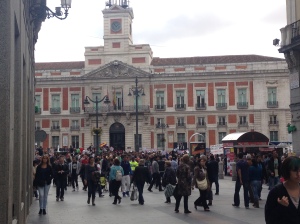

Above: My school on the strike days.
The week before this past week, students and teachers went on strike due to changes in education laws. Students went on strike Tuesday and Wednesday as well as marched on the Comunidad de Madrid government building in Puerta del Sol on Wednesday. Teachers went on strike on Thursday and that night marched on the Comunidad de Madrid building. As is typical, both protests began at the Atocha train station and walked up to Puerta del Sol.
Below: The student protest in Puerta del Sol.

My understanding of the new education law, known as “la ley Wert” or “la LOMCE,” is that it will cut education funds while also adding some new educational procedures. A Social Science teacher that I work with explained to me that the new law will make Catholic Religion classes mandatory at all public schools and students will receive a grade for the class. At my secondary school, students can choose to take Catholic Religion or a History of Religion class and they do not receive a grade for either course. Students in secondary school will also be required to take a government test at the end of each year. This test alone will determine if they can move onto the next grade. If they fail the test but pass all of their classes, they will still have to repeat the year. Currently, students decide whether or not they will attend “bachillerato,” the last two years of high school that will prepare them for university, when they are 15 or 16 years old. The law will mandate that students make this decision one year earlier at the ages of 14 or 15 years old. Essentially, students are deciding whether or not they want to go to university during the American equivalent of their first year of high school. Finally, this law will cut government funding to universities and to scholarships for students to attend university. The result being that fewer students will be able to afford to attend university.

At my school, student government representatives began announcing the strike in different classes two weeks before the actual strikes. They did their best to explain to their classmates why the strikes were taking place. I definitely noticed a difference between what issues troubled the first year representatives versus the second year representatives. The first years were worried about the government test while the second years were worried about going to college. I really appreciated that my bilingual coordinator told her classes to research the new law further and discuss it with their parents so that they could make an informed decision about striking.
On Tuesday, October 22nd, there were much fewer students at my school. The first and second years (the equivalent of 7th and 8th graders) needed parental permission to go on strike from school. At least half of my first years were in class, so we proceeded as planned. However, in both of my second year classes, only 6 students or less attended class! It meant that my co-teachers and I had to quickly change our plan for the day. In my second year English class, we played hangman to practice vocabulary and read travel brochures. In my second year Social Science class, we still watched a New York Times youtube video and had a discussion BUT we also ended class by watching those “Annoying Orange” videos. The second years thought the videos were hilarious as did Ricardo, the Social Science teacher (I personally didn’t see the appeal).
On Wednesday, October 23rd, many more students were missing. I teach all first year classes on Wednesdays. Two classes continued as planned but my last two classes watched movies since more students were missing. The teachers didn’t want to have to re-teach material once students returned to school. One of my English teachers, Eugenia, showed Love Actually in class. She told me that this way they could practice their English and they would be able to finish the movie later with her during “tutoría,” Citizenship class. Now, I want you to imagine watching Love Actually with 12 year-olds. There is plenty of nudity in that movie (remember the two stand-ins for movie lighting in sex scenes?) and yet none of my students giggled or seemed especially uncomfortable. The teacher had no problems showing it to students (also, I know she has little kids). It all seemed very normal for them. I, on the other hand, felt so strange watching this with my students. It was an experience that exposed cultural differences. First, I kept thinking about how at my middle school my parents would’ve needed to sign permission slips for me to watch this in class. Second, it just felt so strange to watch this with 12 year-olds because they seem so little to me. Talk about awkward times for the auxiliar.
Then, in Social Sciences, with the same exact first year class, the teacher showed Troy. She told me that it made sense to show them the movie since they will switch from learning Geography to Ancient History later in the year. I remember when Troy came out; I was 13 or 14 years old and could not go see “R” rated movies by myself. I made my mom come with my friends and I so that we could get into the movie. While we only watched the first hour of Troy, there’s still plenty of violence and nudity in that first hour. One of my students put her head on the table and refused to watch the movie. The teacher, Elena, asked her (while Orlando Bloom and Diane Kruger are naked on screen): “What’s wrong?” She replied: “They’re naked.” Elena then said: “What’s wrong with that? It’s just the human body. It’s natural.” The student looks up at the screen and says vehemently: “Que asqueroso! (“how disgusting”). Then, the rest of the class and teacher started laughing. Fifteen minutes later, the student still wasn’t watching the movie. The teacher asked, “Do you not like the movie? They’re not naked anymore.” The student responded: “NO!”
I also sat in on an informal meeting in the teacher’s lounge on Wednesday. One of the English teachers shared information about the teachers’ protest on Thursday. It was fascinating how respectful teachers were of each others’ decision to strike or not to strike. All striking teachers were going to lose 150 euros of pay for not attending school. Many teachers vocalized that they understood if people needed to come to work in order to have sufficient income. Other teachers spoke about how they wanted to respect the strike only if the majority of faculty were participating.
On my way home on Wednesday, I got off the metro at the Vodafone Sol stop. I walked into the students’ protest against the new education law. Puerta del Sol was filled with students wearing the green protest shirts and large signs. The riot police had blocked off Calle Mayor and were keeping a close eye on the protesters. Students were still marching up to Puerta del Sol and continued to fill up the area.
On Thursday, October 24th, I arrived at school to find that the majority of my school’s teachers were participating in the teachers’ strike. None of the five teachers I work with attended school that day. I spoke with Pablo, the school principal, and he told me that I would sit in the library all day. All students had been informed that they were to go to the library with a “guardia” (an “on-duty” teacher) and the auxiliares if their teacher was not in class. Pablo told me to talk in English with students from my classes. I would estimate that maybe 50 students attended school that day. Basically, I talked to the few students from my classes who were in attendance and my fellow auxiliares all day. Only 7 or 8 students from my four classes of approximately 30 students came to school.
Something that really surprised me was how scheduled these strikes are. Rather than draw out the strike until the government abolishes the law, school resumed as usual on Friday.
This past week, I dealt with train strikes. October 29th through November 1st, were partial train strikes for the ADIF and cercanías lines due to a government attempt to break up the train workers’ union. These partial strikes will continue for every Monday and Friday of November and for a few select days in December. Partial strikes mean that the trains still run but only 75% of trains run during peak hours and 50% run during non-peak hours. I had no train troubles, thank goodness! However, on Thursday afternoon, I could not get a seat on the train, which is very rare.
Expect more posts soon about lost phones and plumbing issues… when it rains, it pours!
xoxo
Nona






